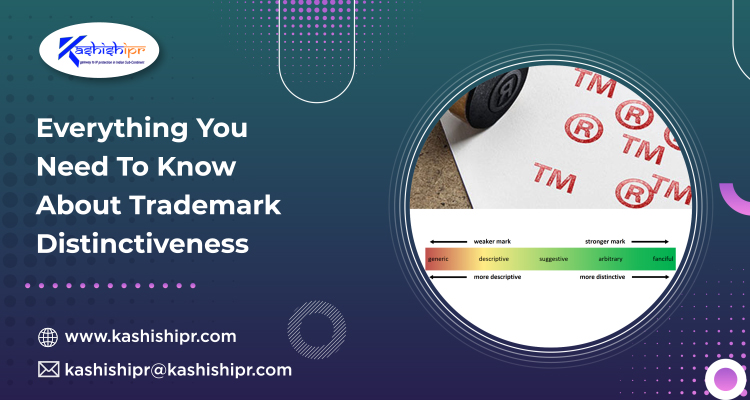Everything You Need To Know About Trademark Distinctiveness
 Posted On
Posted On
Whether you are considering filing your first Trademark Application or you own plenty of Registered Trademarks, you must know and understand that the first step to getting your trademark is distinctiveness.
The ultimate question in this scenario is, “What makes your products, name, or logo stand out in the market?” Or, “What is going to attract business?” Here in this article, we shall discuss trademark distinctiveness, its different levels, and how possessing adequate knowledge can help you successfully register your proposed trademark.
What is Trademark Distinctiveness & Why Does it Matter?
Trademark distinctiveness refers to how unique your mark is relative to your offerings, i.e., the products (like books, cups, etc.) or services (like legal services, business consulting, etc.) you sell. It refers to the features of your mark identifying your offerings as originating from a specific company. You must evaluate well how distinctive your trademark is relative to the types of products and services that you’re going to use it with as a part of your business or brand. Remember, you can’t get through with the process of Trademark Registration if your proposed trademark isn’t distinctive enough.
Let’s now discuss the different trademark categories that shall help you understand if your proposed trademark is distinctive enough to obtain Trademark Protection. Understanding and utilizing the categories mentioned below hold immense power to make or break your trademark application.
- Arbitrary & Fanciful or Coined Phrase Marks
The first category includes the most distinctive marks – arbitrary and fanciful or coined phrase marks. All these can refer to any image, word, or color having no association with the products or services you are trying to sell.
- Fanciful Phrase – It refers to something you just come up with out of nowhere. To be specific, it may consist of a coined phrase or an invented name. For instance, Xerox is a made-up word.
- Arbitrary Phrase – It refers to something that is not necessarily made up; however, it has an arbitrary relationship or no relationship with the type of products or services you sell. Consider the example of the famous Apple Inc. – the tech giant has nothing to do with an apple except for its use in its logo.
Kindly note that arbitrary and fanciful or coined phrase trademarks are the best when it comes to successfully registering your mark as a trademark. However, you must also note that they are undoubtedly the hardest marks to use in the industry from a marketing point of view as they have no association with your offerings. They don’t tell anything to your customers about the type of products or services you sell to them.
- Suggestive Marks
The second level of trademark distinctiveness deals with suggestive marks. Suggestiveness implies that the phrase, slogan, colors, words, or images you use don’t necessarily describe the product or service you’re selling; however, they do suggest the type of thing you’re selling; for instance, Netflix for streaming services and Airbus for airplanes.
*Threshold of Registrability – Trademark distinctiveness falls into four major categories. The two trademark categories described above are above the threshold for what you can register as a trademark and the remaining two fall below the threshold. They are called merely descriptive and generic marks.
- Merely Descriptive Marks
A mark is considered merely descriptive if it describes the quality, characteristic, feature, function, ingredient, use, or purpose of the products or services mentioned in the trademark application. In other words, it means you describe the aspect or thing you’re selling or doing. An example of a merely descriptive mark would be ‘creamy and cold’ for ice cream.
- Generic Marks
Generic marks refer to the ones that, with continuous use over the period, become so widely recognized in the daily use of language by the general public that the mark isn’t anymore associated with the specific brand or business entity, and instead, it assumes the meaning of a specific product and/or service itself.
Marks such as Aspirin, Cellophane, and Velcro have gained a generic status in society today due to their extensive use in a manner where they are interchangeably used in day-to-day conversation for a product or service identical in nature and not necessarily associated with the original brand name.
How to Come Up With a Distinctive Trademark?
Here are a couple of aspects you may consider to fall above the generic and merely descriptive threshold:
- Use words or names that have more than a single meaning. In general, if there’s a second meaning attached to a word or name, specifically if that meaning plays well into the type of business you do, it becomes convenient to argue that the same is suggestive and not merely descriptive.
- Search for some mark that is counterintuitive. Look for something that isn’t what you were expecting or thinking about in your mind. It might have some relationship with your offerings in the industry, but at the same time, you wouldn’t expect somebody to use it as a trademark for their offerings.
- If you are willing to use a coined phrase, pair up your mark. Let us assume that you have made up a name that you really like, but you need to associate it with the products or services you sell. In such a scenario, you may consider pairing up your mark.
- Otherwise, if you select an arbitrary, fanciful, or coined mark and match it up with a descriptive phrase, you can get a trademark on the mark itself and use the descriptive phrase in your marketing strategy and advertising campaigns to inform your customers about your products or services. ✅ For more visit: https://www.kashishipr.com/
